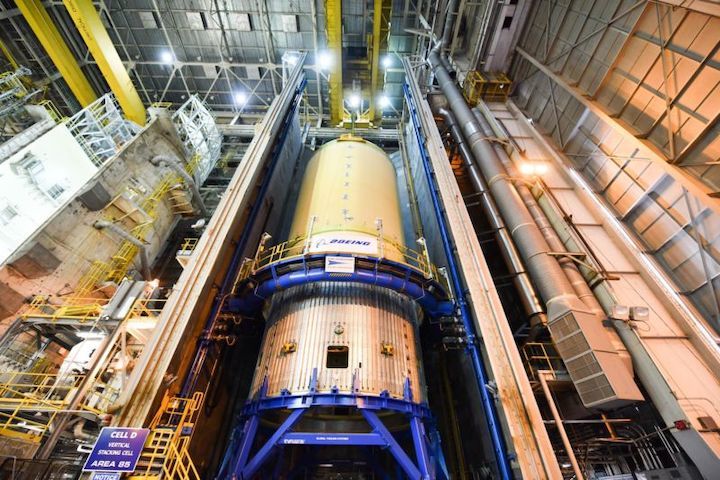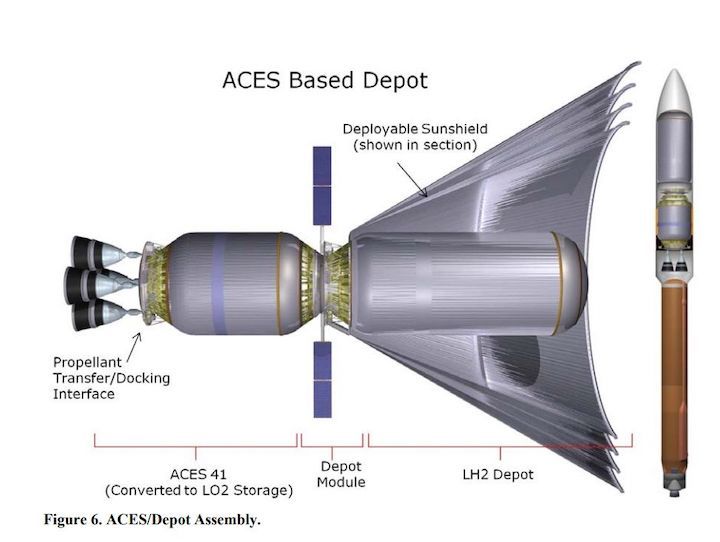2.08.2019

The Space Launch System (SLS) rocket’s liquid oxygen tank structural test article was manufactured and stacked in June 2019 at NASA’s Michoud Assembly Facility in New Orleans.
Nearly a decade ago, when Congress directed NASA to build a large rocket based upon space shuttle-era technology called the Space Launch System, the agency also quietly put on the back burner its work to develop in-space refueling technology.
It has long been rumored within aerospace circles that funding for NASA's efforts to develop so-called propellant depots, and the capability to store and transfer cryogenic rocket fuels in orbit, was curbed due to the threat it posed to the SLS rocket and its prime contractor, Boeing.
After all, if smaller, cheaper rockets could launch rocket fuel and stash it in low-Earth orbit for staged missions to the Moon or beyond, why should NASA spend $2 billion a year annually to develop the SLS rocket? Why not just use that money to buy commercial launches, starting with the Delta IV Heavy and later the Falcon Heavy, and build an exploration program around existing capabilities? It would likely be quicker and cheaper.
Now, thanks to comments on Twitter by George Sowers, a physicist in the middle of this controversy, we have confirmation of sorts. In the early and mid-2010s, Sowers was leading the advanced programs group at United Launch Alliance (ULA), the rocket company co-owned by Boeing and Lockheed Martin. Propellant depots were among the technologies he was working on. Sowers is now a professor at the Colorado School of Mines.
ULA works on depots
One of ULA's chief assets was its Centaur upper stage, and the company wanted to build an innovative version that could be refueled in space, and reused, called the Advanced Cryogenic Evolved Stage, or ACES. As part of this development, in 2011, ULA proposed an in-space test of depots to NASA that would cost less than $100 million.
"We had released a series of papers showing how a depot/refueling architecture would enable a human exploration program using existing (at the time) commercial rockets," Sowers tweeted on Wednesday. "Boeing became furious and tried to get me fired. Kudos to my CEO for protecting me. But we were banned from even saying the 'd' word out loud. Sad part is that ULA did a lot of pathfinding work in that area and could have owned the refueling/depot market, enriching Boeing (and Lockheed) in the process. But it was shut down because it threatened SLS."

A spokesman for Boeing said he would look into these comments, and Ars will update this story if Boeing responds. The chief executive of United Launch Alliance, Tory Bruno, told Ars late in 2018 that ACES development remained "further out" on the company's roadmap.
Sowers' suggestion that "depots" should not be uttered in public is consistent with observations at the time that a US Senator from Alabama, Richard Shelby, had told NASA to stop talking about propellant depots. The NASA spaceflight center that manages the SLS rocket's development, Marshall Space Flight Center, is based in Alabama.
Can't count on Falcon Heavy?
Publicly, in the early and mid-2010s, proponents of the large SLS rocket were critical of depots because they asserted the technology was not ready for prime time. Then-NASA Administrator Charles Bolden also said the agency could not plan its exploration plans around the Falcon Heavy and propellant depots because the SpaceX rocket was not a real rocket.
"Let's be very honest again," Bolden said in a 2014 interview. "We don't have a commercially available heavy lift vehicle. Falcon 9 Heavy may someday come about. It's on the drawing board right now. SLS is real. You've seen it down at Michoud. We're building the core stage. We have all the engines done, ready to be put on the test stand at Stennis... I don't see any hardware for a Falcon 9 Heavy, except that he's going to take three Falcon 9s and put them together and that becomes the Heavy. It's not that easy in rocketry."
SpaceX privately developed the Falcon Heavy rocket for about $500 million, and it flew its first flight in February 2018. It has now flown three successful missions. NASA has spent about $14 billion on the SLS rocket and related development costs since 2011. That rocket is not expected to fly before at least mid or late 2021.
The depot topic has flared back up this week because NASA's Space Technology program announced that it would work with SpaceX, as part of a Space Act Agreement in which no funds are exchanged, to help develop on-orbit refueling for the company's Starship vehicle. It marked the first time NASA has really formally recognized Starship. It also signaled that NASA now appears to be willing to take the concept of on-orbit refueling seriously again. This has likely been spurred by senior officials in the White House. Vice President Mike Pence, who leads the National Space Council and has been supportive of commercial efforts, has even mentioned propellant depots in speeches.
Quelle: arsTechnica
